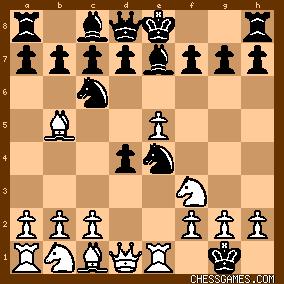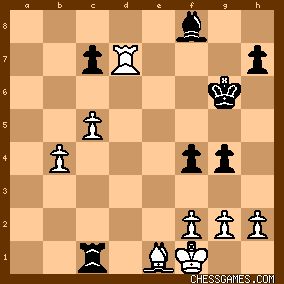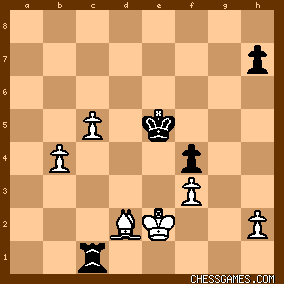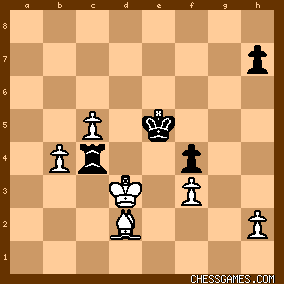|
< Earlier Kibitzing · PAGE 2 OF 2 ·
Later Kibitzing> |
| Nov-01-03 | | Javid Danowski: This ending is a lot more dificult than I originally thought. One final try, though: 41 Kd1 Rh3, 42 b5 Rg6; 43 c7 Rg8; 44 Bxf4+ Kd5; 45 b6 Kc6; 45 Be3 when I feel White should have at least good winning chances, since the Black K must stay if front of the White b- and c- pawns. White can block the h-pawn with his Q, forcing Black to put his rook behind the h-pawn and then advance his own f-pawn. If white can get his K to g7 without allowing the h-pawn too far forward he should win. |
|
| Nov-02-03 | | Cyphelium: <Javid Danowski> I assume that you start with dk's 39.- Rh1 40. c6 Rxh2+? Then if 41. Kd1 Rh3??, 42. c7 wins immediatly for white. Even if 41.- Rh3 was playable, it just throws away a tempo, letting white play b4-b5. So, if instead 41.- Rg2 42. c7 Rg8, there is no Bxf4+. I have tried two other ways. 39.- Rh1 40. Kd3 Rxh2 41. b5!?. This seemed promising, but: 41.- Kd5 42. c6 Rg2 43. c7 Rg8 44. Bxf4 Kc5 45. Bg5 Rc8 (only move) 46. Bd8 Kxb5 47. f4 Kc6 48. f5 Kd7 49. Ke4 Rxd8 50. cxd8Q+ Kxd8 is a draw, e.g. 51. Kf4 Ke7 52. Kg5 h6+ 53. Kxh6 Kf6. So I tried (same as above until) 44. Bb4!?, but after 44.- Rc8 45. b6 Kc6 46. Bc5 Kb7 47. Ke4 Rg8 48. Kxf4 h5, it looks like white has to play 49. Be7 and after 49.- Kxb6 it's a draw again. |
|
| Nov-02-03 | | drukenknight: So black can hold this? Just verifying to see if that your conclusion. Thanks for putting in the effort, cyph/javid. Its fun to play this stuff with you guys. |
|
| Nov-02-03 | | Resignation Trap: Poor Didier finished last in this tournament. At Monte Carlo 1901, he also finished last, with a final score of one-quarter of a point! |
|
| Nov-03-03 | | Cyphelium: <dk> That's the conclusion. Right now 39.- Rh1 seems to hold the game. At any rate it's far better than what black played in the game. |
|
Nov-03-03
 | | Chessical: I too believe that white's 27th should be Rd5. It is given in another source as this and actually makes more sense. |
|
Apr-26-18
 | | KEG: yet another up and down performance by Janowski. Playing against tail-ender Didier, Janowski exploited weak opening play by his opponent, won a pawn, and had what looks like a won game within about 10 moves. From there, Janowski played as if he thought the game would win itself. Didier, knowing he was in trouble, tried a desperate King-side pawn advance and hit the jackpot when Janowski overlooked a simple tactical resource and allowed Didier to build up an attack and pin that should have at least led to a draw. But then Didier, made a fatal blunder and resigned. Remarkably, Didier's game-losing blunder was his 40th move, not his 39th as everyone else seems to think. Incidentally, and as several users on this site have noted, the 27th move of Janowski was 27. Rd5, not 27. Rd4 as reported here. 1. e4 e5
2. Nf3 Nc6
3. Bb5 Nf6
4. d4
4. 0-0 is more usually played here. But the text, though not posing any serious dangers for Black, is entirely playable, though it yields at best a tiny edge to White. 4... exd4
This, 4...Nxd4, and 4...Nxe4 are all reasonable lines. 5. 0-0 Be7
Black can transpose to other lines with 5...a6 (Yudovich). The text, however, is also fine. 6. e5 Ne4
6...Nd5 is a good alternative, but Black is also fine with the text. 7. Re1
The position was now:

click for larger view7... d5?
Black was OK before this precipitous advance. Now, however, he gets into immediate trouble. With 7...Nc5, Black would have been fine. 8. exd6 e.p. Nxd6
9. BxN+ bxB
10. Nxd4
That Didier has lost ground is clear by comparing the position now with that after 7. Re1: 
click for larger viewBlack's Queen-side pawn structure is shattered and he now has numerous weaknesses. 10... Bd7?
This only made matters worse for Didier. For better or worse, he had to play 10...Qd7, retaining the chance to play Bb7. 11. Qf3
"Well played. This move gives White the advantage." (Rosenthal in the Tournament Book). While the text does indeed give White a strong advantage, better still for Janowski would have been 11. Qe2 11... 0-0
As Rosenthal correctly pointed out, 11...c5 would have been bad after 12. Nc6 BxN 13. QxB Kf8 14. Nc3. With the text, though the best move at Black's disposal, White wins a pawn and--with best play--the game. 12. Nxc6 BxN
13. QxB Rb8
14. Nc3 Re8
Slow developing play is inadequate here with Black a pawn down. He should had tried 14...Bf6 or perhaps 14...Nf5. 15. Nd5
As usual, Janowski courts trouble. The simple 15. b3 was best, though Janowski still has the game in hand even after the text. 15... Bf8
16. RxR QxR
Rosenthal claimed--for reasons I cannot fathom--that 16...NxR was better. Keeping Queens on the board can hardly help Didier here. 17. QxQ NxQ
The position was now:

click for larger viewWith Janowski up a pawn in this prosaic position and Didier having no counterplay to speak of, the game is a clear win for White with best play. But this requires technique and patience. Janowski was not what one would call a patient player and so he got into trouble in this ending. As I will begin to try to show in my next post on this game, Janowski played well until about move 31, but then messed up his position and--had Didier not blundered--would at best have obtained a draw. |
|
Apr-27-18
 | | KEG: Post II
If Janowski thought that after the exchange of Queens he would blow Didier away quickly, he was soon relieved of that expectation. 18. b3
A reasonable plan. Also reasonable were 18. Kf1 (getting the King into action) or 18. Nf4. 18... Rd8
19. Ne3 f5
19...Bc5 might seem normal here, but Didier apparently decided that routine play in his pawn-down position would lead to certain defeat. He therefore banked all on a wild King-side pawn storm. 20. Bb2 f4
Once again, Didier abstains from a routine 20...Bc5 or 20...g6. He tries to gain time by this attack of Janowski's Knight. 21. Nc4
There is nothing wrong with the text, but the cute 21. Rd1 was another option, and probably would have resulted in an immediate exchange of Rooks, reducing Didier's potential counterplay and avoiding the loss of time involved in the text. 21... Nd6
Trading Knights was hardly in Didier's interest. Given his hope of generating a King-side attack, he should have played 21...Rd5. 22. Rd1 Re8
23. NxN
23. Ne5 was probably stronger, but reducing material favors Janowski here, so the text was certainly not bad. 23... BxN
The position after the exchange of Knights was:

click for larger viewIn what follows, the one dangerous theme Janowski must consider is a possible f3 by Black. Didier's f4 pawn is, after all his only trump at this stage. But Janowski simply ignores the issue and takes no heed of the important of the f3 square--until the one time playing f3 is bad for him--on move 35. 24. Kf1 Kf7
Didier might have considered playing 24...f3 here to "mess up his opponent's hair." 25. c4
The text, while not terrible, serves little purpose at this point. Janowski should either have played 25. f3 (eliminating the threat of f3 by Black once and for all), or 25. Rd5. Janowski seems to be playing by rote here, always a dangerous course. 25... g5?!
One must admire Didier's spunk. He was down a pawn and almost certainly lost, but he tried to rustle up complications. 26. Bc3 g4?!
Pursuing his plan, but he might have considered 26...f3?! The position was now:

click for larger viewI give this position because, as several users on this site have correctly noted (e.g., Javid Danowski Chessical), the move given here: 27. Rd4; would make much the the play through move 29 bizarre. As Yuri54 points out, if Janowski had indeed played 27. Rd4, then why didn't he simply capture Didier's Rook after 29...Re4. The Tournament Book gives Janowski's move here as 27. Rd5, and I will assume that this was the move played in my analysis. 27. Rd5
This seems best, and White's win now seems assured. But with Janowski at the helm, all things are possible! 27... Kg6
28. c5! Bf8
29. b4
White's Queen-side pawn majority should quickly have decided the game from here. 29... Re4
29...Re7 seems most prudent, but Didier was long past worrying about that by this point. 30. Rd7! Rc4?!
Once again, 30...Re7 seems the prudent move. But Didier is staking all on attack. The position was now:

click for larger viewWith Didier's Queen-side pawns about to fall, the game appears to be nearing the finish. But, as I will discuss in my next post on this game, it was from here that Janowski lost his way, and Didier almost escaped with a draw, and--for a moment--even seemed to have a chance to win. |
|
Apr-27-18
 | | steinitzfan: White to move after Black's 29th. Now there's a Monday puzzle. |
|
Apr-27-18
 | | KEG: Post II
I agree with steinitzfan that 30. Rd7! was a fine winning move (or at least theoretically winning move). After 30...Rc4, however, Janowski began to flounder. 31. Be1
"A mistake which should compromise his game. The right move was 31. Bd2." (Rosenthal in the Tournament Book). White is still very much on top after 31. Be1, but Rosenthal is surely correct that 31. Bd2 was much better (if 31... Rc2 32. Bxf4 is more than sufficient). It is hard to explain Janowski's choice here. But his more significant mistakes were yet to come. 31... a5
31...Rc1 looks much better. 31...Bg7 and then 32...Rc1 was another possibility. But the text obviously spooked Janowski, who missed the clear refutation. 32. a3
This also does not endanger Janowski's winning chances, but once again it is hard to understand what he was thinking, since 32. bxa5 seems to win easily. 32... axb4
33. axb4 Rc1
33...Bg7 immediately was probably better.
The position was now:

click for larger view34. Rxc7
As Rosenthal noted in the Tournament Book, Janowski's win would be gone after 34. Ke2? f3+ 35. gxf3 gxf3+, and here he could actually lose with 36. Kd2?? (36. Kf1 is good enough for equality) Bh6+!. The text is OK, but Janowski could have brushed off Didier's coffee-house attack with 34. f3! Janowski still is in charge here, but now he has to play very carefully. 34... Bg7!
Preparing to exploit the pin on the White Bishop on e1. The position was now:

click for larger viewDidier's threats (most notably Bc3) were obvious. White can deal with his problems--as Rosenthal correctly noted--with 35. Re7! But Janowski erred badly here with: 35. f3?
This move, that would have been so excellent on Janowski's prior turn, should now have ended his winning chances. 35... gxf3
Did Janowski really miss this?
Perhaps even simpler for Black was 35...Bc3, as pointed out by user Javid Danowski on this site many years ago. The position was now:

click for larger viewThings have obviously gone poorly for Janowski over the course of the past few moves, and his winning chance are probably gone, but there was no need for him to panic. Under the rules at Paris 1900, draws were replayed. So Janowski could have headed for a draw with 36. gxf3 or 36. Re7 and then looked to beat the hapless Didier in a rematch. But instead: 36. RxB+?!
This wild sacrifice of the exchange suddenly gives Didier chances to win what had seemed a dead lost position a few moves ago. 36... KxR
37. gxf3 Kf6
37...Rc2 would have made life even more miserable for Janowski. But even after the text he should at least have been able to hold Janowski to a draw. 38. Ke2 Ke5
39. Bd2
The position was now:

click for larger viewDidier still probably has the better chances with best play, but--as I will show in my next post on this game--the game came to a shocking conclusion in just two moves. How this occurred, and the commentary on the finale by Rosenthal in the Tournament Book and by many users on this site, warrant a separate post. |
|
Apr-28-18
 | | KEG: Post IV
In the position with which I ended my last post (which I misnumbered "Post II), Didier played: 39... Rc4
This seems to put the Rook on an awkward square. Rosenthal in the Tournament Book called the move "A mistake which loses the game." Is that correct. Is Black lost here?
As I will attempt to show in this post: (A) Black is not only not lost but even has the better chances after Rosenthal's proposed 39...Rb1; (B) 39...Rh1, analyzed in detail on this site, is sufficient for a draw; and (C) even after Didier's 39...Rc4 Black should not have lost and Janowski prevailed only because of Didier's blunder on his next move (40...Kd5??). (A) In the Tournament Book, Rosenthal claimed that 39...Rb1 was sufficient for equality. Indeed, it is the best move for Black here, and even gives Black the better chances. Rosenthal's analysis of this move, however, was flawed. Rosenthal's proposed line continued 40. Kd3 Rb3+?. But this line actually loses for Black after 41. Kc4 (e.g., 41...Rxf3 42. b5). The problem in this line is Rosenthal's awful 40. Rb3+. Black is not only fine but has the better chances with 40...Kd5! (stopping White's pawns in their tracks). Similarly, if 41. Bc3+ Black has the better position after 41...Kd5. In sum, Didier should have played 39...Rb1 and it would then have been Janowski who would have had to fight for a draw. (B) 39...Rh1, though presenting no real dangers for White, was good enough for a draw. Following the line given here by user drukenKnight: 40. c6
40. Kd3 is also fine for White here and also leads to a draw. 40... Rxh2+
40...Kd6 is also sufficient for Black to hold the position here. 41. Kd3 Rh6??
41...Rg2 draws here [e.g., 42. c7 Rg8; 42. b5 Kd5) But 41...Rh6 loses. 42. b5
Black's Rook is misplaced, and it is too late for Black to recover: 42... Rd6+
43. Kc3
drukenKnight's 43. Kc2 is only sufficient for a draw after 43...Rd5 44. b6 Rc5+ 45. Kd3 [but not drukenKnight's 45. Bc3+? Kd6 46. c7 Kd7 47. Kd3 Rb5 (rather than drukenKnight's 47...h5? which only draws after 48. Bf6...but which actually wins on his 48. Be1? Rb5 By contrast, after the correct 43. Kc3? Black has no answer against the advanced White King-side pawns: (e.g., 43...Rd8 44. Bc1! Kd6 45. Kc4 Returning to the actual game, it is remarkable that the much-maligned text (39...Rc4) still allows Black to hold the game, as will be shown below. After 39...Rc4, Janowski played:
40. Kd3
This was best for White, and left the position as follows: 
click for larger viewDidier here played:
40... Kd5??
But 40...Rd4+ draws easily (e.g., 41. Kc3 Kd5). It is strange that this simple drawing line was missed by Rosenthal. After Didier's actual move, however:
41. Bc3!
Now Black is definitely lost:

click for larger viewAnother tragedy for Didier in this tournament.
1-0 |
|
May-04-18
 | | OhioChessFan: For kicks I ran a Stockfish analysis of 39..Rh1. 1) =0.00 (63 ply) 40.Kd3 Kd5 41.Bxf4 Rb1 42.Bd2 h5 43.h4 Rh1 44.Bg5 Rb1 45.Kc3 Rf1 46.f4 Rf3+ 47.Kb2 Kc6 48.Kc2 Kd5 49.Kb2 2) =0.00 (63 ply) 40.c6 Kd6 41.b5 Rb1 42.Bxf4+ Ke6 43.c7 Kd7 44.Be5 Rxb5 45.f4 Rb3 46.Kf2 Rh3 47.Kg2 Rb3 48.h4 Kc8 49.h5 Kd7 50.Kh2 Rd3 51.Kg2 Rb3 3) -0.46 (62 ply) 40.h3 Rh2+ 41.Kd3 Kd5 42.Bxf4 Rxh3 43.Ke2 Rh4 44.Ke3 h6 45.Bd6 Rxb4 46.Kf2 Rc4 47.Kg3 Ke6 48.Kf2 Kf5 49.Kg3 Rc2 50.Bf8 h5 51.Bd6 Rc3 52.Kg2 Kg5 53.Be7+ Kf4 54.Bd6+ Kf5 55.Kg3 Rd3 56.Kg2 Rd4 57.Kg3 Rd5 58.Kh3 Rd1 59.Kh4 Kg6 60.Be7 Rf1 61.Kg3 Rc1 62.Bd6 Rc3 63.Kf2 Kf7 64.Kg3 Rc4 65.Kh2 Kf6 66.Kh3 Rc1 67.Kg3 Rc2 68.Kh4 Kg6 69.Kg3 Rc4 70.Kg2 Rd4 71.Kf2 Rd1 72.Kg3 Rc1 73.Kg2 Rc4 74.Kg3 |
|
May-04-18
 | | KEG: <OhioChessFan>Thank you. This deep search you have performed tends to confirm that 39...Rh1 would indeed have been sufficient for a draw, as many users on this site had concluded. I would be interested to know what such a deep search on Stockfish would reveal for 39...Rb1, which I think is best for Black. |
|
May-04-18
 | | WannaBe: <KEG> Here you go: 1) -0.08 (50 ply) 40.Kd3 Kd5 41.Ke2 Rb3 42.Bxf4 Rxb4 43.Bd6 Rc4 44.Kf2 Rd4 45.Ke3 Rh4 46.Ke2 Ke6 47.Kf2 Rb4 48.Ke3 Rc4 49.Kd3 Ra4 50.Ke3 Kd5 51.Kd3 Ra3+ 52.Ke2 Ke6 53.Kf2 Rc3 54.Kg3 Kf5 55.Kg2 Rc4 56.Kf2 Rc2+ 57.Ke3 Rc3+ 58.Kf2 Rc1 59.Kg2 Rc2+ 60.Kg3 Rd2 61.Kh4 Rd3 62.Kg3 Rd4 63.Kf2 Rd2+ 64.Ke3 Rc2 65.Kd3 Rb2 66.Kc4 Rf2 2) -0.08 (49 ply) 40.Bc3+ Kd5 41.Bd2 Rb3 42.Bxf4 Rxb4 43.Bd6 Rc4 44.Kf2 Rd4 45.Ke3 Rh4 46.Ke2 Ke6 47.Kf2 Rb4 48.Ke3 Rc4 49.Kd3 Ra4 50.Ke3 Kd5 51.Kd3 Ra3+ 52.Ke2 Ke6 53.Kf2 Rc3 54.Kg3 Kf5 55.Kg2 Rc4 56.Kf2 Rc2+ 57.Ke3 Rc3+ 58.Kf2 Rc1 59.Kg2 Rc2+ 60.Kg3 Rd2 61.Kh4 Rd3 62.Kg3 Rd4 63.Kf2 Rc4 64.Kg3 Rc1 65.Kh4 Kg6 66.Kg4 3) -0.08 (49 ply) 40.h3 Rb3 41.Kf2 Rb2 42.Ke1 Kd5 43.Kd1 Rb3 44.Ke2 Rb1 45.Kf2 Rb2 46.Ke1 h5 47.Kd1 Rb3 48.Ke2 Rb1 49.Kf2 Rb2 50.Ke1 Kc6 51.Ke2 Rb3 52.Kf2 Kd7 53.Ke2 Ke6 54.Kf2 Ke5 55.Ke2 Kd5 56.Kf2 Ke6 57.Bxf4 Rxb4 58.Bd6 h4 59.Ke3 Rc4 60.Kd3 Ra4 61.Ke3 Rb4 62.Kf2 Rb3 63.Bf4 Rc3 64.Bg5 Rxc5 65.Bxh4 Rh5 66.Bg3 Rg5 67.h4 Rg8 68.h5 Kf7 69.f4 Rc8 70.h6 |
|
May-04-18
 | | offramp: <WannaBe: <KEG> Here you go...> <KEG> does many lovely analyses of chess games. I really enjoy reading them. Then some guy with a pooter posts something like this: <<KEG> Here you go:
1) -0.08 (50 ply) 40.Kd3 Kd5 41.Ke2 Rb3 42.Bxf4 Rxb4 43.Bd6 Rc4 44.Kf2 Rd4 45.Ke3 Rh4 46.Ke2 Ke6 47.Kf2 Rb4 48.Ke3 Rc4 49.Kd3 Ra4 50.Ke3 Kd5 51.Kd3 Ra3+ 52.Ke2 Ke6 53.Kf2 Rc3 54.Kg3 Kf5 55.Kg2 Rc4 56.Kf2 Rc2+ 57.Ke3 Rc3+ 58.Kf2 Rc1 59.Kg2 Rc2+ 60.Kg3 Rd2 61.Kh4 Rd3 62.Kg3 Rd4 63.Kf2 Rd2+ 64.Ke3 Rc2 65.Kd3 Rb2 66.Kc4 Rf22) -0.08 (49 ply) 40.Bc3+ Kd5 41.Bd2 Rb3 42.Bxf4 Rxb4 43.Bd6 Rc4 44.Kf2 Rd4 45.Ke3 Rh4 46.Ke2 Ke6 47.Kf2 Rb4 48.Ke3 Rc4 49.Kd3 Ra4 50.Ke3 Kd5 51.Kd3 Ra3+ 52.Ke2 Ke6 53.Kf2 Rc3 54.Kg3 Kf5 55.Kg2 Rc4 56.Kf2 Rc2+ 57.Ke3 Rc3+ 58.Kf2 Rc1 59.Kg2 Rc2+ 60.Kg3 Rd2 61.Kh4 Rd3 62.Kg3 Rd4 63.Kf2 Rc4 64.Kg3 Rc1 65.Kh4 Kg6 66.Kg4 3) -0.08 (49 ply) 40.h3 Rb3 41.Kf2 Rb2 42.Ke1 Kd5 43.Kd1 Rb3 44.Ke2 Rb1 45.Kf2 Rb2 46.Ke1 h5 47.Kd1 Rb3 48.Ke2 Rb1 49.Kf2 Rb2 50.Ke1 Kc6 51.Ke2 Rb3 52.Kf2 Kd7 53.Ke2 Ke6 54.Kf2 Ke5 55.Ke2 Kd5 56.Kf2 Ke6 57.Bxf4 Rxb4 58.Bd6 h4 59.Ke3 Rc4 60.Kd3 Ra4 61.Ke3 Rb4 62.Kf2 Rb3 63.Bf4 Rc3 64.Bg5 Rxc5 65.Bxh4 Rh5 66.Bg3 Rg5 67.h4 Rg8 68.h5 Kf7 69.f4 Rc8 70.h6> It looks like a mountain of garbage. |
|
May-06-18
 | | KEG: <WannaBe>Thank you. I guess this shows, my analysis notwithstanding, that Black has nothing better than near equality with either 39...Rh1 or 39...Rb1. |
|
May-06-18
 | | KEG: <offramp> Thank you for your kind comments. I am glad you enjoy reading my posts. While I generally agree with you about long computer runs that have little to do with actual over-the board play, in this case I specifically requested this in my response to OhioChessFan, and thus WannaBe's comment was at my express suggestion. Thus, in this instance (much as I share your general view) any criticism must be directed at me. I was just wondering whether 39...Rb1 might perhaps give Black some winning chances. I now think I have my answer. |
|
May-06-18
 | | offramp: I apologise for flying off the handle! |
|
May-06-18
 | | KEG: <offramp> No apologies necessary! Many (and perhaps most) of us share your general feelings on this topic. |
|
| May-06-18 | | thegoodanarchist: < offramp:
It looks like a mountain of garbage.>
Actually, this is what a mountain of garbage looks like: https://en.wikipedia.org/wiki/Mount... |
|
| May-06-18 | | morfishine: Dear <offramp> On your comment <I apologise for flying off the handle!> Obviously, there's no need to digress to such elementary cliche' And pardon me, if I may say so myself, and this is a rather trivial matter, BUT 'apologize' is spelled with a 'Z'
***** |
|
| May-06-18 | | jith1207: Apologise is the non-American version, or the English that most other countries use. |
|
May-06-18
 | | perfidious: In British English, verbs ending in -ize in American/Canadian English are instead usually -ise. |
|
| May-07-18 | | ChessHigherCat: So you can anglicise "Americanize" or else Americanize "anglicise". |
|
May-07-18
 | | offramp: <perfidious: In British English, verbs ending in -ize in American/Canadian English are instead usually -ise.> That's right. But <Morfizhine> is correct in that I normally use the American -ize because it is closer to the original Greek ending -izein and is almost never wrong.
http://www.dictionary.com/browse/-ize
The American have fixed world English. |
|
 |
|
< Earlier Kibitzing · PAGE 2 OF 2 ·
Later Kibitzing> |
|
|
|





